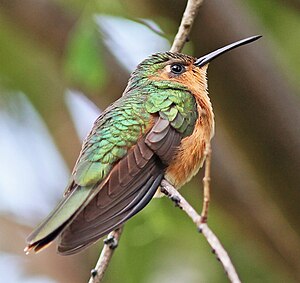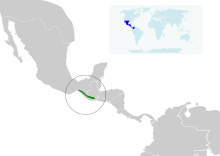Multi-tailed epee wings
| Multi-tailed epee wings | ||||||||||
|---|---|---|---|---|---|---|---|---|---|---|

Multi-tailed epee wings |
||||||||||
| Systematics | ||||||||||
|
||||||||||
| Scientific name | ||||||||||
| Campylopterus rufus | ||||||||||
| Lesson, RP , 1840 |
The spotted sword wing ( Campylopterus rufus ) is a species of bird from the hummingbird family (Trochilidae) that is widespread in Mexico and Guatemala . The IUCN assesses the population as Least Concern . The species is considered to be monotypical .
features
The multi-tailed sword wing reaches a body length of about 12 to 14 cm, the males have a weight of about 9 g. The females are a little lighter with 6 to 6.9 g. The male has a black curved bill. The top glitters bronze-green. There is a small white point behind the eye. The underside is completely cinnamon in color. On the slightly rounded tail, the central control feathers are golden bronze, the others are light cinnamon-colored with a black subterminal band and cinnamon-colored borders. The hems on the outermost tail feathers are a little lighter. Females are similar to males, but they are slightly smaller. Young birds are similar to adult birds, but have yellow-brown fringes on their head feathers.
Behavior and nutrition
The spotted sword wing gets its nectar u. a. of plants of the genera plantain , coral trees , sage and castilleja . He catches insects in flight by chasing them. The male defends his foraging territory with plants rich in nectar. He looks for his food in the lower strata in the thick undergrowth and in clearings.
Vocalizations
The singing of the multi-tailed sword wing contains sharp nasal skik tones, a somewhat more metallic sounding plik and two-syllable hum that sounds like chirri . The singing can also consist of a longer series of similar chirping tones, interrupted by chattering and trilling phases.
Brood
The breeding season of the harlequin rapier wing in Oaxaca is from April to May. Males make little leks . The nest, a chalice-shaped structure, is covered with moss and whitish mistletoe waste. The outside is decorated with braids. He attaches the nest to a horizontal branch one to two meters above the ground. A clutch consists of two eggs. The incubation period lasts between 15 and 16 days and the eggs are only incubated by the female. The chicks are blackish with two yellow-brown stripes on the back. The nestlings fledge at around 23 to 26 days.
distribution and habitat
The harlequin rapier wing prefers rainforests and forest edges, canyons with scattered forests, moist pine and oak forests and plantations. It moves at altitudes between 900 and 2000 meters, occasionally down to sea level. It is most common over 1300 meters.
migration
The multi-tailed sword wing is considered to be a resident bird , which as a line bird occasionally migrates locally depending on the availability of flowers between the high altitudes.
Etymology and history of research
The first description of the multi-tailed epee wing was in 1840 by René Primevère Lesson under the scientific name Campylopterus rufus . Lesson does not mention where the type specimen came from. In 1827 William Swainson introduced the new genus Campylopterus . This word is derived from the Greek »kampylos καμπύλος « for »curved, curved« and »-pteros, pteron πτερο « for »-fluted, wing«. The species name "rufus" is the Latin word for "red, red-brown, fox-red".
literature
- Karl-Ludwig Schuchmann , Guy Maxwell Kirwan , Peter Boesman in: Josep del Hoyo, Andrew Elliott, Jordi Sargatal , David Andrew Christie, Eduardo de Juana: Rufous Sabrewing (Campylopterus rufus) In: Handbook of the Birds of the World Alive . Lynx Edicions, Barcelona.
- James A. Jobling: Helm Dictionary of Scientific Bird Names . Christopher Helm, London 2010, ISBN 978-1-4081-2501-4 .
- René Primevère Lesson : Oiseaux-Mouches rare ou nouveaux, communiqés par MM. Longuemare et Parzudaki, faisant du t. IV inédit de l'histoire naturelle des Oiseaux-mouches de M. Lesson . In: Revue Zoologique par La Société Cuvierienne . tape 3 , 1840, p. 71-74 ( biodiversitylibrary.org ).
- William Swainson: On several Groups and Forms in Ornithology, no hitherto defined . In: The Zoological journal . tape 3 , no. 11 , 1827, pp. 343-363 ( biodiversitylibrary.org ).
Web links
- Campylopterus rufus inthe IUCN Red List of Threatened Species 2019.2. Listed by: BirdLife International, 2016. Retrieved August 5, 2019.
- BirdLife International: Species Factsheet - Rufous Sabrewing ( Campylopterus rufus ) . Retrieved August 5, 2019.
- Videos, photos and sound recordings of Rufous Sabrewing (Campylopterus rufus) in the Internet Bird Collection
- Spotted sword wings ( Campylopterus rufus ) at Avibase; accessed on August 5, 2019.
- Campylopterus rufus in the Integrated Taxonomic Information System (ITIS). Retrieved August 5, 2019.
- xeno-canto: sound recordings - pied-tailed sword wings ( Campylopterus rufus )
- Rufous Sabrewing (Campylopterus rufus) in the Encyclopedia of Life . Retrieved August 5, 2019.
Individual evidence
Remarks
- ↑ He assigned the gray-breasted rapier wing ( Campylopterus largipennis ( Boddaert , 1783)) (Syn: Trochilus latipennis) and the redtail rapier wing ( Campylopterus falcatus ( Swainson , 1821)) to the new genus .
